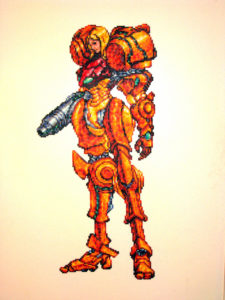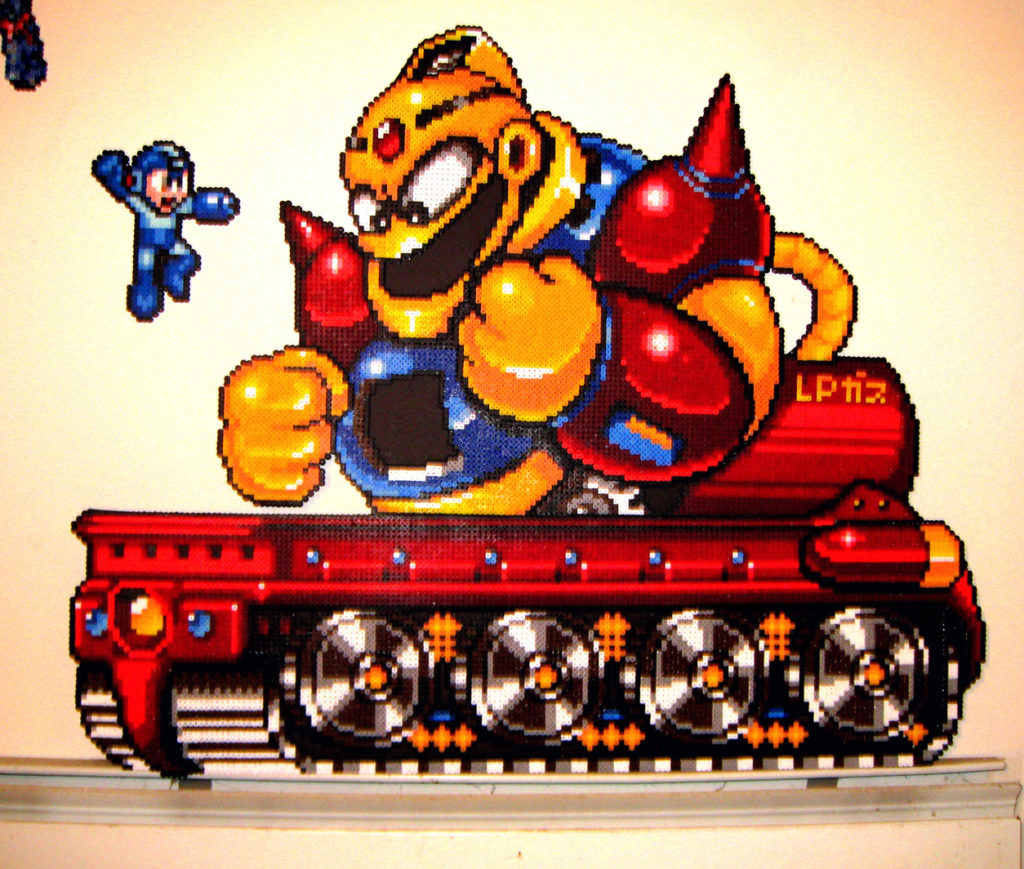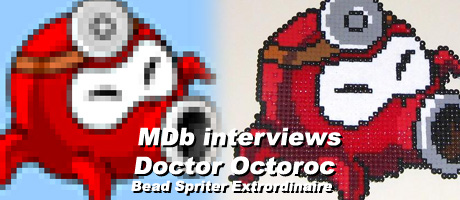
The MDb Interviews Doctor Octoroc
Originally published by Infinity’s End
08.08.08
Doctor Octoroc is a budding artist whose passion for gaming has led him to begin creating massively detailed “bead sprite” art, which consists of game sprites (or sometimes hand-drawn art turned into sprites) made out of Perler Beads. We got a chance to talk to the Doc, and here’s his story. (And be sure to visit his DeviantArt page to see more of these stunning creations!)
State your real name, age, and current place of residence.
Levi Buffum, 26, Philadelphia, PA
Is “Doctor Octoroc” your real-life alias as well or just your internet one?
Yes. I originally coined the name to represent my musical style on the piano. “OCTO” for the 88 keys on the piano and 8-Bit video games that I generally would play on the piano; ROC for the style of music, as I played piano rock, similar to the style of Ben Folds. I wanted to form a piano driven rock band named “Octoroc” but could find neither a drummer or upright bass player for such an endeavor. Ultimately, I appended the “Doctor” to the Octoroc, as a sort of pop-video-game-comic-culture reference (as the Octorock is one of the first enemies you encounter in the original “Legend of Zelda” and I cannot begin to list the number of doctors in video game, comic and cartoon history). Plus, I don’t think Tektite or Peehat has the same flair…
Do you have a website or any other place on the web where people can see your work and contact you?
Doctoroctoroc.com – for the time being it is a blog but I plan to eventially have a fully interactive website showcasing artwork, music and more all in one interface (I also do Flash animation). I can be contacted by e-mail as well: jazzlevi[at]yahoo.com.
Other than bead sprites, what other types of art do you create/have created?
I paint pixels with acrylic on canvas – pixelated nudes (with country flag overlays), and still life like bowls of fruit – the type of subjects one would expect to see in the renaissance section of a museum. I also do a lot of pixel art, such as the Here Comes a New Challenger compilation album cover. As I mentioned, I play piano, but over the past few years, I’ve been doing a lot of remixing – mainly classic Nintendo tunes. I use FL Studio and AcidPRO mostly, but I’d like to get into Ableton Live for shows and the such. I also write here and there, novels mostly, but I’ve only ever finished one.
What are your feelings on the Metroid series of games?
Best. Series. Ever. I like the depth of story without telling much story at all – the feeling of being alone, even in the original – not to mention, a strong, sexy, female lead role. I’d have to say Super Metroid is the best, but I enjoyed the Prime series like I could enjoy no other game, with the exception of Super Metroid..
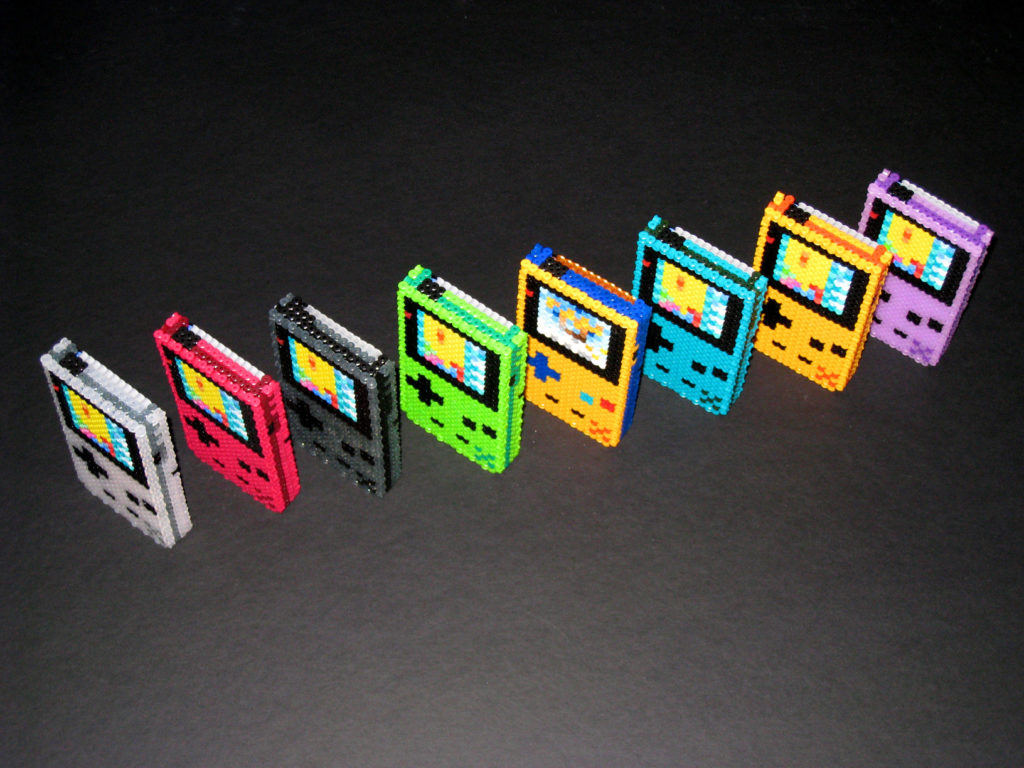 What video game consoles do you own? Any favorites?
What video game consoles do you own? Any favorites?
Atari, Coleco Vision, Nintendo, Super Nintendo, Nintendo 64, 2 Game Cubes, Sega Master System, 3 Genesis’, Saturn and Dreamcast. As far as handhelds go, I have two Gameboys, One of each Gameboy Color, Gameboy Advance, GBA SP, 2 GBA Micros and a Nintendo DS. Right now I mostly play Nintendo or Super Nintendo, one of the many Gameboys (depending on the game) and my DS, a lot. The all time favorite among them would have to be the Super Nintendo. Anything I don’t have, my roomate does – mostly newer systems like Wii, XBox 360 and PS3, but also some classics – Neo Geo, Sega Cd, Turbo Grafix 16, you name it.
Do you prefer 2D over 3D? Any thoughts on the way the industry currently treats 2D games over 3D ones?
I do love to see how far technology has come, but I’ll take the sprites over the 3-D models and texture maps any day. I whole-heartedly sacrifice graphics for gameplay, replay value and story line. However, the industry knows how most people feel about gaming, and continues to push more realistic 3-D graphics, along with movie-like story lines and cinema cut scenes. One of the main reasons I love Nintendo as a company is that they cator to the oldschool, the newschool and the downright old – senior citizens are playing Wii, for crying out loud! I also respect their devotion to their original fans, as they continually bring back their classic characters.
Where would you like to see the industry go in the next 5 years?
I don’t see anything along the lines of virtual reality or holograms emerging (no danger rooms or holodecks) but with the incredible reception of the Wii, this sort of interactive gameplay will definitely be the future for the casual gamer. For the hardcore gamer, I see ridiculously realistic graphics on SDHD (super-duper high definition) screens and gamplay that adapts to each person. It may be enough for some to be able to set your buttons and invert your Y-axis control stick, but I see controllers (wireless of course) that cost $100 bucks a pop and have hundreds of sensors that evaluate the player’s touch/style and adapt to make their control perfect for them. I think the next step for these gaming companies is to develop a large scale, touch screen system – perhaps a combination of the Wii and DS – however, it will likely be Microsoft that releases this sort of system first.
Do you think video games are an art form or have the potential to be an art form?
I think games themselves are art the same way that a film production is art. The process is very similar and a lot of the same tools are used these days – writers, producers, directors, actors, computer graphics (obviously), effects, and so on. My feelings on video games as art, however, are more geared towards the use of video game iconicity, structure, imagery, etc, to present new ideas, or relive old ones. I know it seems biased of me, but I love what my brother Jude is doing right now – he uses classic video game characters and themes to express political and social commentary, usually current. A good example of this would be his “President Kong” painting, which features Donkey Kong and Donkey Kong Jr. as George Bush Sr. and Jr. tossing oil barrels at a Saddam “Mario” Hussein. I personally think that the pixel is the abstract art for the generation of video gamers.
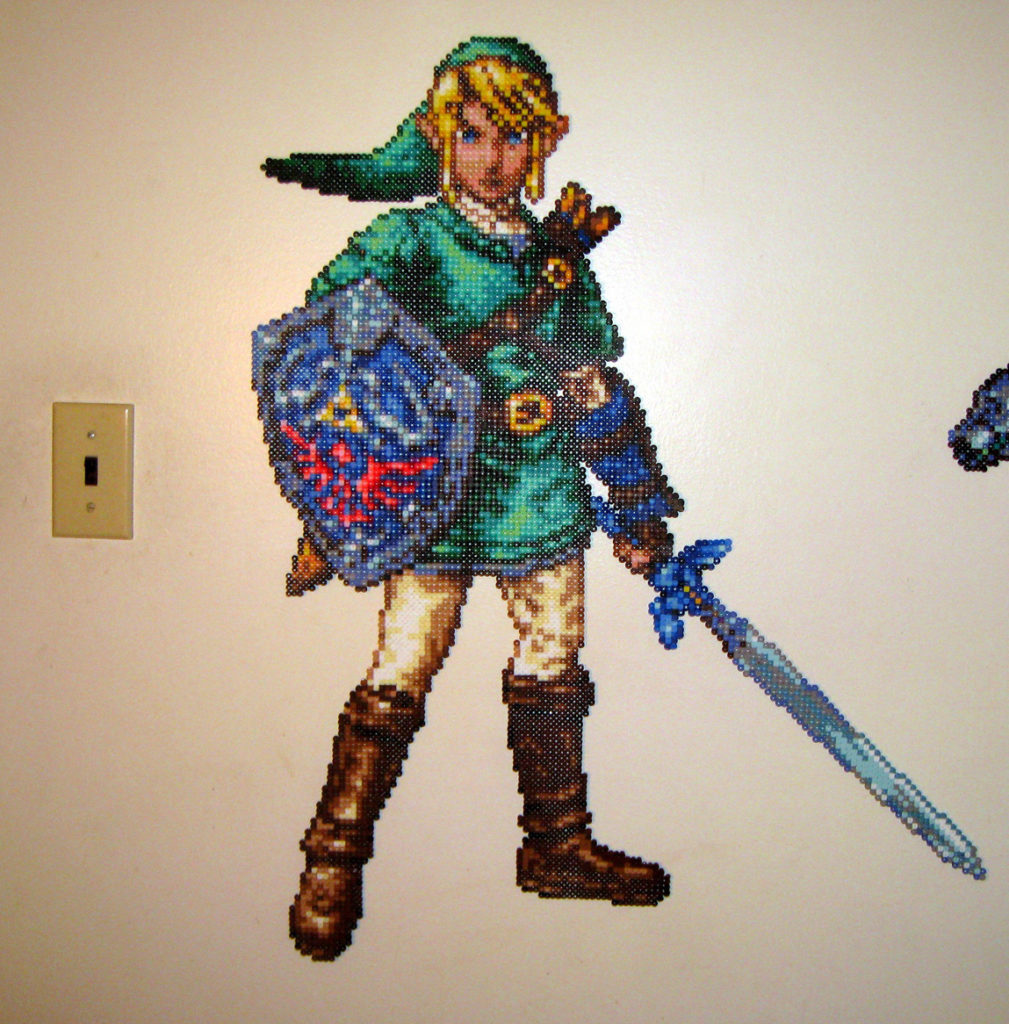 How long have you been making these [bead sprites]?
How long have you been making these [bead sprites]?
I started back in 2006 when my brother bought me a bead sprite made by his fellow bit artist Chris Olian, better known as 8-Bit Artist. I’ve been making them ever since; I’m quite addicted to them.
Can you summarize the process that goes into making bead sprites?
The process itself is not very complicated. The manufacturers of these beads advertise “4 easy steps” to creating fuse bead art. When you get into larger bead sprites, there are many in between steps I take to ensure a quality, sturdy, and attractive piece. Every piece, before being beaded, needs to be drawn (or found if the sprite already exists) and re-colored to the palette of available bead colors, since we aren’t working from patterns in the activity books that these companies also sell. I usually try to do something that no one has done yet, or something so insane no one else would try it. At the end of a given project, it’s all about presentation – should a package it as a “blind-box” item or mount it on a background and sell it to hang? For large pieces, do they stand on their own or should I frame them? And then I’ve done a lot of 3-D pieces (mainly scale or mini versions of various console and and-held systems), which involve a lot of careful planning as to how the interlocking pieces will fit together – sort of like those Puzz 3-D foam puzzles.
How long does it take to do each one, say comparing a small sprite with a large one?
The least time I’ve ever spent on a single bead sprite is around ten or fifteen minutes, from design or re-color to being ironed. On the other end of the spectrum, I have spent countless hours just drawing out, designing or coming up with the idea for a piece. The number of beads definitely factors into the time frame for these, but a good part of the time I’ll spend on a piece is the ironing process for something I’ve spent 16 hours beading (like the giant replica of Skull Castle from Mega Man 2 that I’m currently working on). Needless to say, I take my time, because one bump and its another hour of work, resorting the colors and placing them back on the pegboard where they belong. The Skull Castle piece, however, will be constructed like my Gutsdozer piece, in layers, where I bead and iron all the pieces seperately then put them together on different levels of depth built out of foam core. My time estimation for Gutsdozer is between 40 and 60 hours of work…Skull Castle will likely be double this time in the end, as it contains the most beads i’ve ever poured into one piece: over 22,000.
When you say a piece has so many thousands of beads, how much does all that material cost?
I figure that each bag of 1,000 beads costs around two dollars (factoring shipping in to the final cost since I order them online). This means that each bead costs .002 cents. Multiply that by the number of beads and you got your total cost. A piece like my custom Samus Aran, (based on the amazing rendition by Torokun from DeviantART) has around 9,500 beads, which costs around 20 bucks to make. Skull Castle, on the other hand, cost about 45 dollars. Add in 15 layers worth of black foam core and the final piece costs about $150.
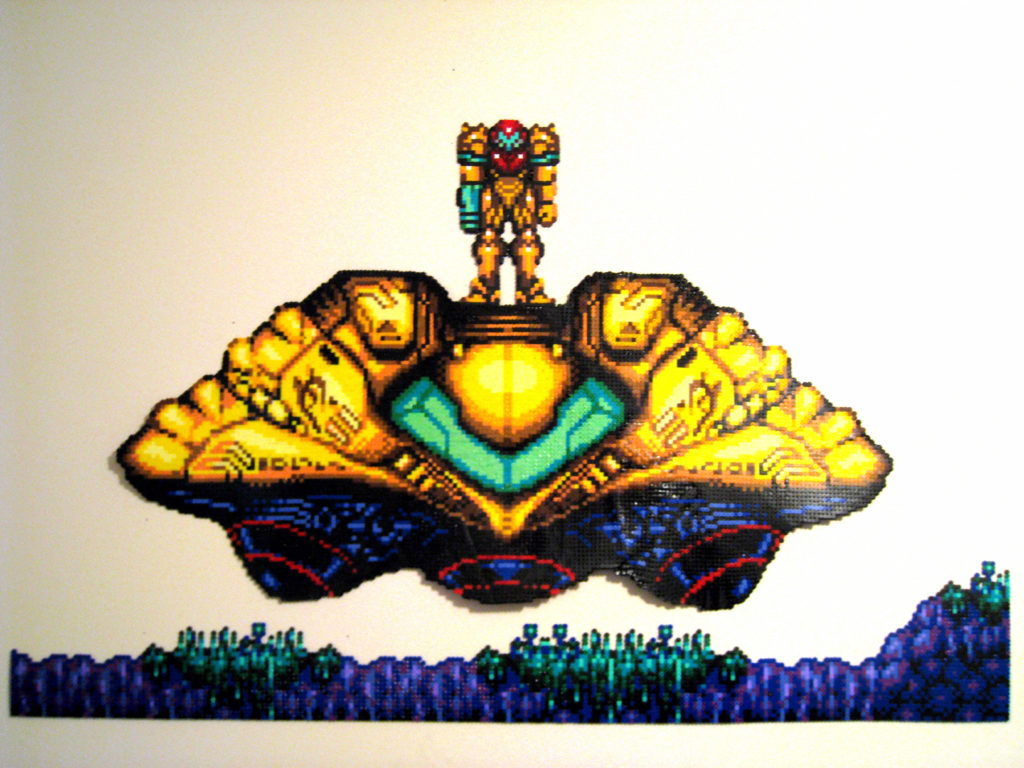 At what level do you consider bead art to be an art form? Have you given any thought to what its expressive potentials might be?
At what level do you consider bead art to be an art form? Have you given any thought to what its expressive potentials might be?
Since I consider pixels to be the basis for my art itself, any and all bead sprites could be considered art. However, it all comes down to the expression of the medium. While I love to see large bead sprites of Final Fantasy bosses or something like my “Samus Aran has Landed” piece, really, anyone can do such a piece given time and motivation. I most enjoy custom bead sprites, like the Torokun Samus, and my series of Soul Calibur and Tekken characters, because I draw them up from scratch, choosing all the colors and where they go. It’s like bringing true-form pixel art to the next level, pulling it from the screen and representing it in real life. I also love the challenge of working with a very limited palette where I am forced to use greys, browns and blues to represent metal.
Obviously your bead sprites derive heavily from pre-existing spritework or other related game-art. Have you considered doing your own artwork and converting them into bead sprites?
I did, at some point, want to bead up some of my pixel paintings using these fuse beads, but it lacked something. Given the nature of what I do with the acrylic, utilizing a plasticy paint for a digital expression on fine art material and basing said paintings on traditional art subjects life nudes and still life, it seemed like a pointless transition. While even my custom pieces are based on video game characters, translating my custom pixel art is how I currently use this medium for more than simple re-creation. I am inclined to continue with video game based or video game inspired subjects for my bead art, but as ideas pop into my head, I will explore. For example, i am currently working on a 3-D Voltron re-creation, to scale with the original toy. I bridged out from the sprites when I created my 3-D consoles, but I found very few other subjects that worked with this 3-D bead sprite method. Then I moved on to layering large pieces and found myself back at the 3-D stuff, with cartoons as my new subject. I could probably recreate classic cars or famous buildings with these beads, but I have little to no passion for these things when compared with my love of video games and the joy they brought me as a kid. It all comes down to nostalgia – if it brings it, I’ll build it. If others can share the joy, all the better.
How do you compare your work with bead sprites to actual pixel art or historical art forms, such as Byzantine or Roman tile murals? It seems pixel art is the closest analogue, but I’ve always thought that tile murals in many ways anticipated the pixel.
I wouldn’t compare fuse bead art to any other art form because I have far too much respect for classic artists, especially the ones that had no idea that they were creating art. I studied art in college, and while Art History was my least favorite subject (I prefer practice over preaching), I thoroughly enjoy going to museums to view art. It’s just not the same in the book as it is in person, and to be honest, I couldn’t care less who made it or where and when it was from – I just want to create art and learn from those that had done so. The thing I love about bead art is that it replicates many art forms, such as sculpture, impressionism, pop-art, abstract, pixel art, cubism, etc. This form, like many modern art forms, is like a mutt from a mix of many purebreeds, only its that mutt you love because it has so much personality and maintains the good qualities of all its predecesors.
Which pixel art do you like the most? Do you find yourself drawn particularly to the style of one game or series over another?
In general, I love Isometric, because it reminds me of the year I spent studying Architecture in college. As far as game specific styles, I’m partial to the sprite art from role-playing games, and how the artists managed to squeeze to much personality and expression into such a small area of pixels, particularly in the 16-Bit Final Fantasy games. There are a good deal of games that have “poor” sprite art, but even they have something to them, if nothing more than a testiment to the limited resources that other “excellent” sprite artists had (especially 8-Bit era), and how they used such a challenging means of expression to express so much.
There’s a lot of people who would probably be interested in buying one of these. Do you do this just as a hobby, or do you also sell your art to make money?
Like many artists, I love having people interested in my work, especially enough to buy pieces from me. My first really good experience with selling bead sprites was at 16-Bit Genocide in Baltimore, MD in August of 2007. I sold a lot of the smaller bead sprites I made and got a lot of good reactions, which encouraged me to make more, go bigger and branch into 3-D stuff. This year, I will once again be in Maryland for 32-Bit Genocide, on August 16, 2008, to sell more of these. I like to price them with the buyer in mind, as gamers are a rare breed, the kind who would spend thousands on video games and all things related to video games, but find it hard to justify spending that money on anything other than official merchandise. I also have to consider the average lifestyle of a gamer, as most do not have money to burn. I want anyone who buys my work to feel like they got their money’s worth, and those people are the rarest breed, most of whom create video game themed art themselves, and therefore are least likely to buy said art. Whether or not I sell pieces, I love to create them, but it is nice if the hobby can at least pay for itself.
Finally, which bead sprite art that you’ve created are you most proud of, and which took the longeset and most effort to create?
If I answer this question now, the former would be the Samus Aran based on Torokun’s design and the Latter would be Gutsdozer. Ask me the day before 32-Bit Genocide, when I will hopefully have finished Skull Castle, and that will be your answer to both questions.
The staff of the Metroid Database would like to thank Mr. Buffum for his time to answer these questions and we wish him the best of luck on his future endeavors!

